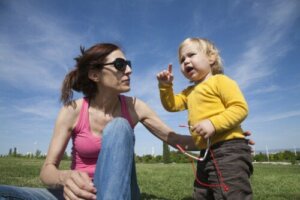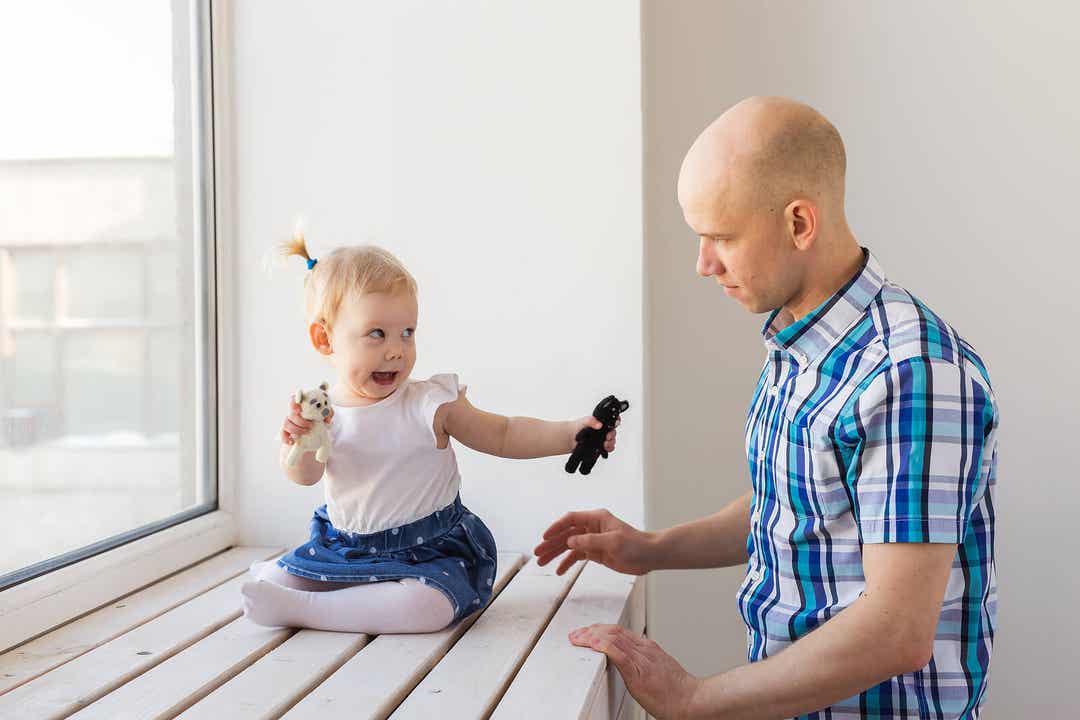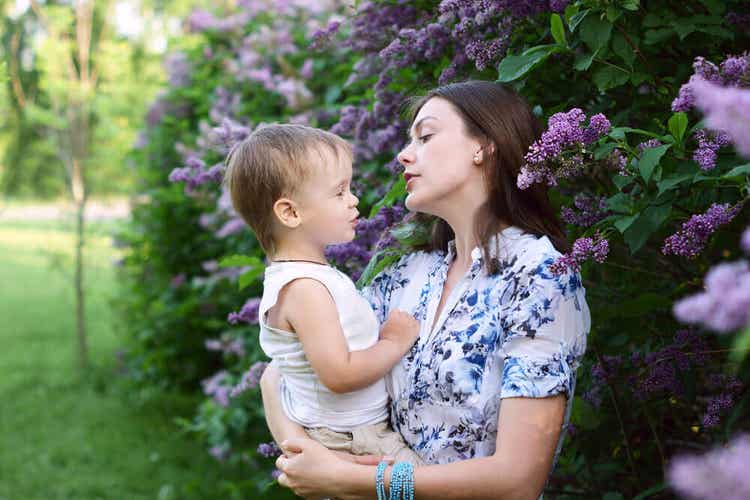6 Ways To Stimulate Babbling in Infants


Written and verified by the psychologist Mara Amor López
When we have a baby, we’re often anxious to hear their first words, to know how their little voice will be, etc. But, before all this, the baby will emit other sounds that, little by little, will become syllables until they produce their first words. This is an important process that we must accompany. So, here are some ways to stimulate babbling from an early age.
With language, a baby expresses their emotions and feelings. From birth, they express themselves through crying, and then, little by little, they emit sounds, and later, they use gestures until they reach words. Do you want to know how to stimulate babies’ babbling at home?
How to stimulate babbling in babies: The four types of babbling that exist
Laura Bosch has published several articles on the phonological assessment of infant language. So, according to her work, let’s take a look at the types of babbling depending on the age of the baby.

At 2 months of age
At this age, babbling begins; normally, little ones emit vowel sounds (a, e, i, o, u) and some loose consonant sounds (k, g…). These first babbling sounds aren’t very clear and have no communicative intention, but are simply emissions that babies enjoy hearing themselves.
Around 4-5 months
At this point, simple, marginal, or isolated babbling occurs. Babies continue to generate vowel and consonant emissions, but in a clearer way, with greater duration and intensity. The baby plays with their hands and puts them in their mouth, touches their lips and tongue, so the articulation of these emissions is more developed. For example, they often say things like “uuuuuu, ggggg, pppppp, aaaaaaaa…”.
Around 6-7 months
Here, canonical babbling appears. These are the first syllabic emissions, composed of a vowel and a consonant, for example: “po-po, ga-ga, ba-ba, pa-pa…”.
Around 9-10 months of age
From the age of 9 months, varied or complex babbling begins. Here, they already emit their first syllables in a complex form, which already include different vowels with different consonants. This will lead to the beginning of their first words. For example: “pa-pa, ma-ma, pi-pi”, etc.
From 12 to 18 months
Little ones begin to say their first words (around three) and begin to know their body parts and identify them. At around 14 months, they repeat the words they hear and already use the word “no”. Despite reproducing few words, they’re able to understand more than 200 words.
From 24 to 30 months
Here, children won’t stop talking; most children are already beginning to form sentences of four or more words, although each child has different characteristics and evolves in their own way.
Ways to stimulate babbling in babies
You already know more about the evolution of speech in babies during their first year. Now it’s time to start stimulating this babbling to prepare the child to utter their first words. Do you want to know how you can do it?
Sing songs
Babies love songs and melodies; what they don’t like in the least is silence, as inside mommy’s tummy there were always noises. That’s why you can sing to them; this way, you vary the intonation, which is more melodic and attractive to their ear.
Repeat their sounds to stimulate babbling in babies
When you repeat their utterances or babbling, they like it and, in addition, it’s beneficial for them, as you can repeat them and, at the same time, correct the way they articulate. You also help them to improve the clarity of their utterances.

Vary your tone when you speak
It’s good to speak to them in different tones and to be soft and sweet. This will stimulate their hearing and help them differentiate between different tones.
Regulate the speed at which you talk to him
Be careful when talking and speak slowly and slower than you would when talking to an adult or older child.
Have conversations and talk to them frequently
Even if they’re small, you should talk to your children and, when they make vowel sounds, answer them, as if you were having a conversation with them. This will stimulate more babbling and their interest in imitating you, and it will give way to the development of a communicative intention.
Massage and caress their mouth
During all the previous activities to stimulate babbling, it’s advisable to put your little one right in front of you, not only so they can see the mouth movements, but also so they can look at you. While you sing and talk to them, you can caress their mouth; this will stimulate them to initiate movements.
The importance of stimulating babbling in babies
As you’ve seen in this article, babies make their first sounds during the first months of life; therefore, it’s important to stimulate the babbling of little ones for the proper development of speech in the corresponding stages.
Language evolves from slight vowel emissions in their first months, to the emission of their first words around 12 to 18 months, although this may vary depending on each child. Now, get down to work, and don’t forget to talk to your baby from the time they’re born!
When we have a baby, we’re often anxious to hear their first words, to know how their little voice will be, etc. But, before all this, the baby will emit other sounds that, little by little, will become syllables until they produce their first words. This is an important process that we must accompany. So, here are some ways to stimulate babbling from an early age.
With language, a baby expresses their emotions and feelings. From birth, they express themselves through crying, and then, little by little, they emit sounds, and later, they use gestures until they reach words. Do you want to know how to stimulate babies’ babbling at home?
How to stimulate babbling in babies: The four types of babbling that exist
Laura Bosch has published several articles on the phonological assessment of infant language. So, according to her work, let’s take a look at the types of babbling depending on the age of the baby.

At 2 months of age
At this age, babbling begins; normally, little ones emit vowel sounds (a, e, i, o, u) and some loose consonant sounds (k, g…). These first babbling sounds aren’t very clear and have no communicative intention, but are simply emissions that babies enjoy hearing themselves.
Around 4-5 months
At this point, simple, marginal, or isolated babbling occurs. Babies continue to generate vowel and consonant emissions, but in a clearer way, with greater duration and intensity. The baby plays with their hands and puts them in their mouth, touches their lips and tongue, so the articulation of these emissions is more developed. For example, they often say things like “uuuuuu, ggggg, pppppp, aaaaaaaa…”.
Around 6-7 months
Here, canonical babbling appears. These are the first syllabic emissions, composed of a vowel and a consonant, for example: “po-po, ga-ga, ba-ba, pa-pa…”.
Around 9-10 months of age
From the age of 9 months, varied or complex babbling begins. Here, they already emit their first syllables in a complex form, which already include different vowels with different consonants. This will lead to the beginning of their first words. For example: “pa-pa, ma-ma, pi-pi”, etc.
From 12 to 18 months
Little ones begin to say their first words (around three) and begin to know their body parts and identify them. At around 14 months, they repeat the words they hear and already use the word “no”. Despite reproducing few words, they’re able to understand more than 200 words.
From 24 to 30 months
Here, children won’t stop talking; most children are already beginning to form sentences of four or more words, although each child has different characteristics and evolves in their own way.
Ways to stimulate babbling in babies
You already know more about the evolution of speech in babies during their first year. Now it’s time to start stimulating this babbling to prepare the child to utter their first words. Do you want to know how you can do it?
Sing songs
Babies love songs and melodies; what they don’t like in the least is silence, as inside mommy’s tummy there were always noises. That’s why you can sing to them; this way, you vary the intonation, which is more melodic and attractive to their ear.
Repeat their sounds to stimulate babbling in babies
When you repeat their utterances or babbling, they like it and, in addition, it’s beneficial for them, as you can repeat them and, at the same time, correct the way they articulate. You also help them to improve the clarity of their utterances.

Vary your tone when you speak
It’s good to speak to them in different tones and to be soft and sweet. This will stimulate their hearing and help them differentiate between different tones.
Regulate the speed at which you talk to him
Be careful when talking and speak slowly and slower than you would when talking to an adult or older child.
Have conversations and talk to them frequently
Even if they’re small, you should talk to your children and, when they make vowel sounds, answer them, as if you were having a conversation with them. This will stimulate more babbling and their interest in imitating you, and it will give way to the development of a communicative intention.
Massage and caress their mouth
During all the previous activities to stimulate babbling, it’s advisable to put your little one right in front of you, not only so they can see the mouth movements, but also so they can look at you. While you sing and talk to them, you can caress their mouth; this will stimulate them to initiate movements.
The importance of stimulating babbling in babies
As you’ve seen in this article, babies make their first sounds during the first months of life; therefore, it’s important to stimulate the babbling of little ones for the proper development of speech in the corresponding stages.
Language evolves from slight vowel emissions in their first months, to the emission of their first words around 12 to 18 months, although this may vary depending on each child. Now, get down to work, and don’t forget to talk to your baby from the time they’re born!
All cited sources were thoroughly reviewed by our team to ensure their quality, reliability, currency, and validity. The bibliography of this article was considered reliable and of academic or scientific accuracy.
- Casla Soler, M., & Ituero Garcia, B. (2017). ¿Cómo empieza el lenguaje?: Descubrir, explorar y favorecer la comunicación temprana (1.a ed.). EDITORIAL GRAO.
This text is provided for informational purposes only and does not replace consultation with a professional. If in doubt, consult your specialist.








